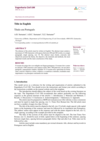Physical behaviour of fibre glass windows
DOI:
https://doi.org/10.21814/ecum.5293Keywords:
Janelas; caixilho em fibra de vidro; desempenho térmico; estanquidade à água; resistência ao vento; permeabilidade ao ar.Abstract
Minimalist windows are an architectural trend that has great commercial value but which also brings up specific challenges. The preference for minimalist systems appears to be enduring, mainly because large window panes with slim frames are aesthetically pleasing and allow more natural light and sunlight to come into a building. However, these solutions, in particular sliding windows, are known to have some functional disadvantages in terms of thermal and acoustic performance, watertightness and durability.
Non-metal window solutions have better thermal behaviour and, even in the most aggressive environments, they are not subject to oxidation and corrosion, which are common phenomena in the currently available solutions. Non-metal frames are lighter and may well have a smaller ecological footprint. However, they have to ensure a good mechanical behaviour and offer adequate wind resistance and watertightness. Fibreglass is one option that can be used to produce frames. The main objective of this work is to present the thermal and physical characterization of windows using this material.
Based on preliminary air permeability, watertightness and wind resistance tests, together with thermal transmittance calculations, the fibreglass solution appears to be promising. This paper presents the results of a programme of experiments carried out at Itecons’ laboratory under the research project “Evoslide”, leaderead by the company FWD.









